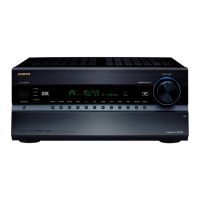What to do if an error occurs during the updating process of my Onkyo Receiver?
- MMelissa NguyenJul 28, 2025
If an error occurs while updating your Onkyo Receiver, disconnect and then reconnect the AC power cord and try the update process again.

What to do if an error occurs during the updating process of my Onkyo Receiver?
If an error occurs while updating your Onkyo Receiver, disconnect and then reconnect the AC power cord and try the update process again.
What to do if I encounter an undefined error during the update of my Onkyo TX-NR1008 Receiver?
Retry the update procedure from the beginning. If the error persists, please contact Onkyo Support and provide the error code.
How to fix Error Code 3-51 displayed on my Onkyo TX-NR1008 Receiver?
To resolve Error Code 3-51 on your Onkyo AV Receiver, disconnect and then reconnect the AC power cord. Start up the AV receiver and select the NET/USB selector. After the 'Now Initializing' display changes, try the update again.
What to do if the Ethernet cable is not detected by my Onkyo Receiver?
If your Onkyo Receiver isn't detecting the Ethernet cable, ensure the cable is properly connected. Refer to the instruction manual for guidance on network connections.
What to do if an error has occurred on my Onkyo Receiver due to wrong selection of input sources?
If an error occurs on your Onkyo Receiver because of incorrect input source selection, turn the AV receiver off and then on again, and then retry the update.
What does 'No Update' displayed on the front of my Onkyo TX-NR1008 Receiver mean?
You do not need to do anything further.
| power output front L/R | 180 W/Ch (6 Ω, 1 kHz, 1 channel driven, IEC) |
|---|---|
| power output center | 180 W (6 Ω, 1 kHz, 1 channel driven, IEC) |
| power output surround L/R | 180 W/Ch (6 Ω, 1 kHz, 1 channel driven, IEC) |
| power output surround back L/R | 180 W/Ch (6 Ω, 1 kHz, 1 channel driven, IEC) |
| power output front high L/R, front wide L/R, or zone 2/3 L/R | 180 W/Ch (6 Ω, 1 kHz, 1 channel driven, IEC) |
| dynamic power 3 Ω front | 300 W |
| dynamic power 4 Ω front | 250 W |
| dynamic power 8 Ω front | 150 W |
| power consumption | 830 W |
| thd (total harmonic distortion) | 0.08% (Rated power) |
|---|---|
| damping factor | 60 (Front, 1 kHz, 8 Ω) |
| input sensitivity and impedance line | 200 mV/47 kΩ |
| input sensitivity and impedance phono mm | 2.5 mV/47 kΩ |
| rated rca output level and impedance | 200 mV/470 Ω (Pre out) |
| maximum rca output level and impedance | 4.6 V/470 Ω (Pre out) |
| phono overload | 70 mV (MM, 1 kHz, 0.5%) |
| frequency response | 5 Hz–100 kHz/+1 dB, -3 dB (Direct mode) |
| tone control bass | ±10 dB, 50 Hz |
| tone control treble | ±10 dB, 20 kHz |
| signal-to-noise ratio line | 110 dB (IHF-A) |
| signal-to-noise ratio phono | 80 dB (IHF-A) |
| speaker impedance | 4 Ω–16 Ω or 6 Ω–16 Ω |
| input sensitivity/output level and impedance video | 1.0 Vp–p/75 Ω (Component and S-Video Y) |
|---|---|
| input sensitivity/output level and impedance component pb/cb, pr/cr | 0.7 Vp–p/75 Ω |
| input sensitivity/output level and impedance s-video c | 0.25 Vp–p/75 Ω |
| input sensitivity/output level and impedance composite | 1.0 Vp–p/75 Ω |
| component video frequency response | 5 Hz–100 MHz/0 dB, -3 dB |
| tuning frequency range fm | 87.5 MHz–108 MHz |
|---|---|
| tuning frequency range am | 522 kHz–1, 611 kHz |
| fm/am preset memory | 40 stations |
| dimensions | 435 x 198.5 x 435.5 mm |
|---|---|
| weight | 18.7 kg |
| carton dimensions | 587 x 337 x 553 mm |
| carton weight | 23.5 kg |
Instructions for connecting the unit to power and ensuring safe operation.
Information regarding FCC compliance for US models.
Details on the amplifier specifications and capabilities.
Overview of the various input and output connection options available.
Identification and explanation of front panel controls and indicators.
Identification and explanation of rear panel connection terminals.
Instructions on how to use the remote to control the AV receiver.
Guidance on connecting speakers and other components to the AV receiver.
Setting up speaker parameters like size, crossover, and type.
Instructions for properly connecting speaker cables to the terminals.
Steps to power on the AV receiver.
How to select and play audio/video from connected sources.
Guide to using the automatic room correction and speaker setup system.
Overview of the on-screen setup menus for configuring the receiver.
Setting up speaker connections, sizes, and crossover frequencies.
Adjusting speaker distance for optimal sound arrival time.
Configuration of Audyssey features like Dynamic EQ and Volume.
Adjusting picture settings like brightness, contrast, and color.
Requirements for connecting the receiver to a network.
Instructions for accessing and playing internet radio stations.
Guidance on connecting speakers for Zone 2 audio playback.
Steps for connecting an iPod or iPhone to the receiver's USB port.
Instructions for playing music files from an iPod or iPhone.
How to find remote control codes for other AV components.
Steps to resolve issues when the AV receiver does not power on.
Troubleshooting steps for audio output problems.
Steps to troubleshoot issues with the remote controller.
Detailed technical specifications for the amplifier.
Specifications related to the HDMI interface and supported formats.
Details on the audio output connections and types.
List of audio formats supported over HDMI connection.
Step-by-step guide for connecting and setting up RIHD-compatible devices.
